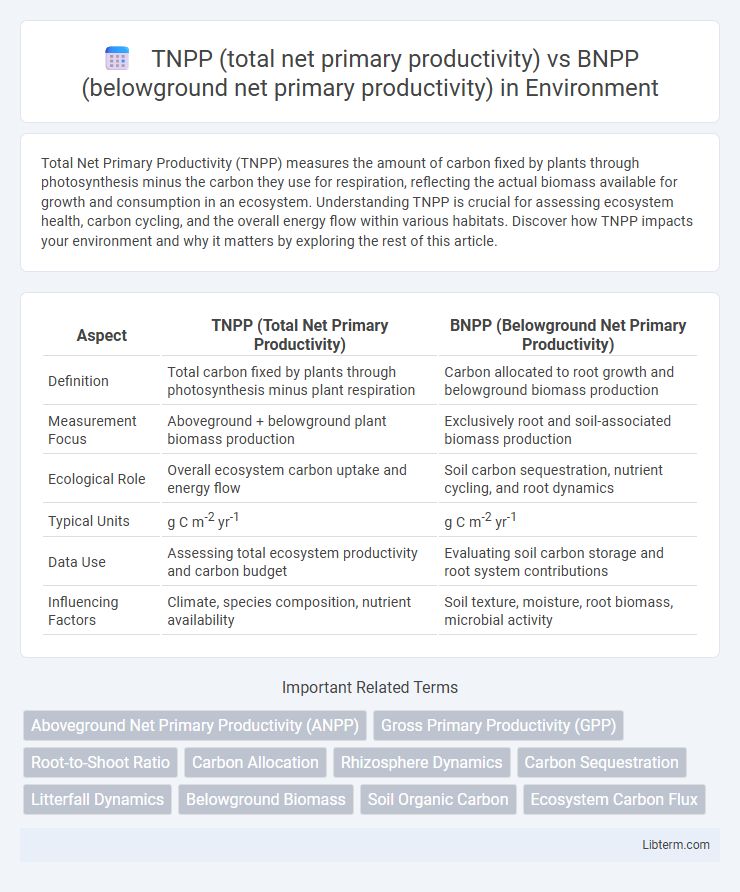Total Net Primary Productivity (TNPP) measures the amount of carbon fixed by plants through photosynthesis minus the carbon they use for respiration, reflecting the actual biomass available for growth and consumption in an ecosystem. Understanding TNPP is crucial for assessing ecosystem health, carbon cycling, and the overall energy flow within various habitats. Discover how TNPP impacts your environment and why it matters by exploring the rest of this article.
Table of Comparison
| Aspect | TNPP (Total Net Primary Productivity) | BNPP (Belowground Net Primary Productivity) |
|---|---|---|
| Definition | Total carbon fixed by plants through photosynthesis minus plant respiration | Carbon allocated to root growth and belowground biomass production |
| Measurement Focus | Aboveground + belowground plant biomass production | Exclusively root and soil-associated biomass production |
| Ecological Role | Overall ecosystem carbon uptake and energy flow | Soil carbon sequestration, nutrient cycling, and root dynamics |
| Typical Units | g C m-2 yr-1 | g C m-2 yr-1 |
| Data Use | Assessing total ecosystem productivity and carbon budget | Evaluating soil carbon storage and root system contributions |
| Influencing Factors | Climate, species composition, nutrient availability | Soil texture, moisture, root biomass, microbial activity |
Introduction to Net Primary Productivity (NPP)
Net Primary Productivity (NPP) quantifies the rate at which plants convert atmospheric carbon dioxide into organic compounds through photosynthesis, subtracting the carbon lost via plant respiration. Total Net Primary Productivity (TNPP) encompasses both aboveground and belowground biomass production, representing the overall carbon assimilation in an ecosystem. Belowground Net Primary Productivity (BNPP) specifically measures the carbon allocated to root growth and soil microbial interactions, playing a critical role in nutrient cycling and carbon sequestration within terrestrial ecosystems.
Defining Total Net Primary Productivity (TNPP)
Total Net Primary Productivity (TNPP) quantifies the total organic carbon fixed by plants through photosynthesis, accounting for both aboveground and belowground biomass production within an ecosystem. TNPP integrates the growth of leaves, stems, and roots, providing a comprehensive measure of ecosystem carbon assimilation and energy flow. In contrast, Belowground Net Primary Productivity (BNPP) specifically measures the production of roots and other subterranean plant structures, which are crucial for nutrient uptake and soil carbon cycling.
Explaining Belowground Net Primary Productivity (BNPP)
Belowground Net Primary Productivity (BNPP) represents the rate at which plants produce biomass in roots and other subterranean tissues, playing a crucial role in carbon cycling and soil nutrient dynamics. BNPP is a significant component of Total Net Primary Productivity (TNPP), directly influencing ecosystem resilience and soil organic matter formation. Accurate measurement of BNPP is essential for understanding plant-soil interactions and forecasting ecosystem responses to environmental changes.
Key Differences between TNPP and BNPP
TNPP (Total Net Primary Productivity) represents the total amount of carbon fixed by plants through photosynthesis, encompassing both aboveground and belowground biomass production. BNPP (Belowground Net Primary Productivity) specifically measures the carbon allocated to root growth and belowground biomass, reflecting investment in nutrient and water acquisition. The key difference lies in their spatial focus, with TNPP integrating entire plant productivity while BNPP isolates the contribution of root systems critical for ecosystem nutrient cycling and soil stabilization.
Measurement Methods for TNPP and BNPP
Measurement methods for Total Net Primary Productivity (TNPP) typically involve integrating aboveground biomass accumulation using remote sensing techniques or harvest-based assessments to capture overall plant growth. Belowground Net Primary Productivity (BNPP) is frequently measured through root ingrowth cores, minirhizotrons, or soil coring to estimate root biomass production and turnover. Both TNPP and BNPP require careful temporal sampling and calibration to account for seasonal dynamics and environmental variability in carbon allocation.
Ecological Importance of TNPP vs BNPP
Total Net Primary Productivity (TNPP) represents the overall carbon fixation by plants, critical for sustaining ecosystem energy flow and supporting food webs. Belowground Net Primary Productivity (BNPP) contributes significantly to soil carbon sequestration, nutrient cycling, and enhancing soil structure, directly influencing ecosystem resilience and productivity. The balance between TNPP and BNPP determines carbon allocation strategies, shaping ecosystem functions and responses to environmental changes.
Factors Influencing TNPP and BNPP
Soil nutrient availability, moisture levels, and temperature significantly influence TNPP and BNPP, with nutrient-rich and well-watered environments typically enhancing overall net primary productivity. Plant species composition and root-to-shoot allocation strategies affect BNPP, as species with extensive root systems invest more belowground biomass, impacting carbon sequestration and soil structure. Disturbances such as grazing, fire, and land-use changes alter resource allocation patterns, thereby modifying the balance between TNPP and BNPP in terrestrial ecosystems.
TNPP vs BNPP in Different Ecosystems
Total Net Primary Productivity (TNPP) encompasses the combined carbon fixation by plants above and below ground, reflecting ecosystem photosynthetic capacity and biomass accumulation rates. Belowground Net Primary Productivity (BNPP) specifically measures carbon allocation to root growth and soil organic matter contribution, varying significantly across ecosystems such as forests, grasslands, and wetlands. In forest ecosystems, BNPP often accounts for 30-50% of TNPP due to extensive root systems, while grasslands typically show higher BNPP proportions relative to TNPP, reflecting adaptation to nutrient and water limitations.
Implications for Carbon Cycling and Storage
TNPP represents the total carbon fixed by plants through photosynthesis, while BNPP accounts specifically for the carbon allocated to root growth, both critical components in ecosystem carbon fluxes. Higher BNPP enhances soil carbon storage by increasing root biomass and organic matter input, promoting long-term carbon sequestration belowground. The balance between TNPP and BNPP influences carbon cycling dynamics, affecting ecosystem resilience and carbon storage potential under changing environmental conditions.
Future Research Directions for TNPP and BNPP
Future research on TNPP should prioritize integrating remote sensing technologies with ground-based observations to enhance spatial and temporal resolution of carbon flux measurements. For BNPP, advancing root phenotyping methods and soil microbial interaction studies will improve understanding of belowground carbon dynamics under varying environmental stressors. Developing coupled aboveground-belowground productivity models will facilitate more accurate predictions of ecosystem carbon sequestration and inform climate change mitigation strategies.
TNPP (total net primary productivity) Infographic

 libterm.com
libterm.com